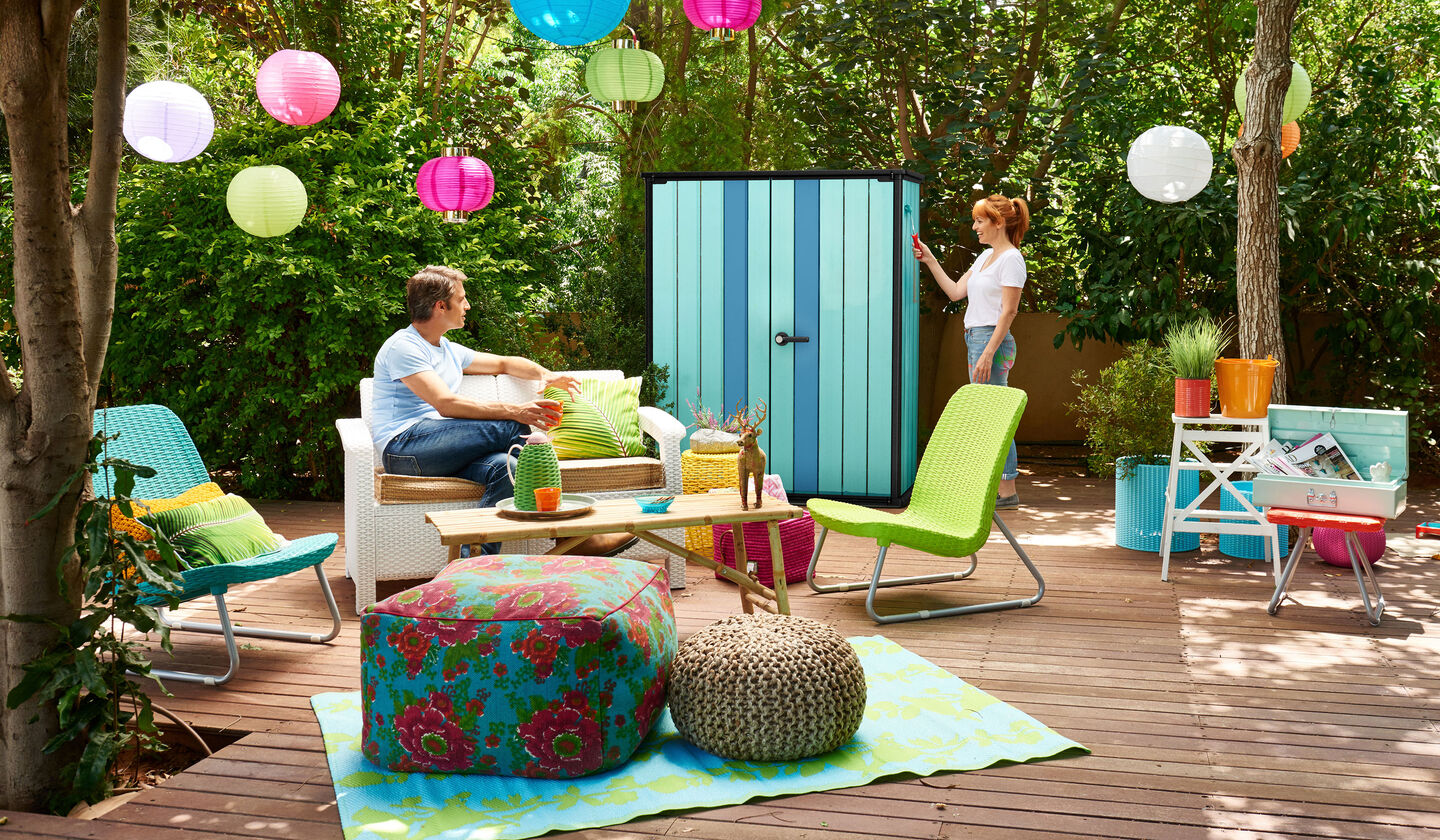.jpg?sw=1440)
How to Choose Colors for Your Shed and Backyard
Are you thinking about what color your shed should be? If you’re here, we’re betting the answer is yes. This doesn’t seem like it should be a hard decision. After all, how many colors are there really, and why does it matter? Well, your storage shed color is a bigger deal than you think. Whether you're adding a new garden shed or updating an old storage space, the color you choose should work with everything around it. This means your house, your fence, your landscaping and even the vibe you're going for outdoors.
If you're not sure where to start, you’re not alone. With so many shed color ideas out there, it might feel overwhelming or like you should know right away. So, to help you out, we’ve pulled together our favorite shed colors, along with expert tips on matching your shed to your home, garden or fence. Whether you’re drawn to soft grays, earthy greens or bold black finishes, there’s a color scheme here that’ll work beautifully with your backyard.
Popular Shed Color Ideas (with Visual Impact)
When it comes to picking a shed color, most people want something that looks great and works with what they already have in their yard. The good news? You don’t need to be an interior designer (or in this case, an exterior designer) to pull this off. There are a few timeless shed color ideas that work in almost any backyard, and we’re breaking them down right here.
Gray, Black or Charcoal: Modern and Sleek
If you love a clean, contemporary look, these colors might be perfect for you. Gray and charcoal are super versatile. So, they can blend in with cooler-toned homes or contrast beautifully with greenery and wood. Black sheds, on the other hand, make a bold statement. They’re dramatic, modern and surprisingly low-maintenance (hello, dirt-hiding).
These neutral shed colors also look great with both light and dark fences, so you don’t have to worry about perfect matching. And if your home has black or gray trim? Even better, your shed will feel like it was meant to be there.
Brown and Wood Tones: Natural and Warm
Love that cozy, earthy vibe? Brown is a classic for a reason. It works well with natural surroundings, especially if your yard has a lot of wood, brick or stone. You can go with a rich espresso brown for something bold, or a lighter cedar tone for a more rustic, cabin-like look. One of our favorites is the classic wood tone you can find on sheds like the Signature Walnut 11x7 resin shed.
These colors blend in beautifully over time, especially as your landscaping grows up around them. If you’re going for a low-key, natural aesthetic, this is your best bet when it comes to storage shed color ideas.
Green: Perfect for Gardens
This might be the most underrated color on the list. A green can make your shed practically disappear into your garden (in a good way) like the Cortina 11x7 resin shed. Green works best in yards with lots of trees, shrubs or flower beds—it feels intentional and organic.
And if you’re using your shed as a garden workspace or potting station, this is a color that just makes sense. It's a nod to nature and one of our favorite garden shed color ideas.
White: Clean and Classic … But Think Twice
White sheds can look amazing in modern, minimal or cottage-style yards. They feel fresh, bright and cheerful. But here’s the deal: they also show everything. Dirt, grass stains and pollen love white surfaces.
If you're set on white, think about going with a slightly off-white or pairing it with a darker trim to break things up a bit. Or look for sheds made of easy-to-clean materials (like the ones Keter makes) to keep maintenance low. White can be stunning, but it takes a little extra care.
How Shed Colors Can Affect the Mood of Your Yard
Here’s something a lot of people don’t think about: color doesn’t just change how your backyard looks, it changes how you and your yard feel. Did you know that there’s something called color psychology that plays a role in how things affect us every day? Different colors naturally create different moods.
For example, when you see the colors black and white together, you might think of police or referees, so you think of rules. What about the colors green or brown? They might signal a more calming feeling you associate with nature. Because of this, the color of your shed can really help set the tone for your outdoor space.
- Cool tones like gray, charcoal and green feel calm, grounded and peaceful. They’re great if your backyard is your escape-from-the-world kind of place.
- Warm tones like brown, tan or terracotta give off cozy, welcoming energy—perfect if you love entertaining outside or want that laid-back, rustic feel.
- Bright colors can energize a space, making it feel more playful and creative. These are great for family yards, gardens or just adding a fun pop to your landscape.
- White and lighter shades reflect more light and can make smaller yards feel more open and airy. Just be ready to wipe off the occasional smudge.
So yes, your shed color choice can influence more than just the curb appeal of your home. The color can help shape how your whole backyard feels when you walk outside.
Should Your Shed Match Your House?

This is one of the first questions people ask when they start picking a shed color: “Should my shed match my house?” And honestly? There’s no one-size-fits-all answer. In some areas, you might be required to have your shed match your house. So, that’s something to look into and keep in mind. However, if that isn’t the case in your state, there are some helpful guidelines that can make your decision a lot easier.
When Matching Works
Matching your shed to your house is usually the safest move, especially if you’re going for a clean, cohesive look. If your home is a classic neutral like gray, beige or white, mirroring that color on your shed can create a seamless flow through your outdoor space. It just makes everything feel intentional and like the shed was always meant to be there.
It’s also a good call if your shed is visible from the street. Matching your home’s color can boost your curb appeal and help your shed blend in rather than stick out. So if you're all about a polished, put-together vibe, this route makes total sense.
When Contrast Looks Better (and Why)
Now, if you’re someone who likes a little personality in your outdoor space, contrast might be the way to go. A shed in a darker or bolder color can stand out in a really beautiful way. This is especially true in a green backyard or garden setting.
For example, if your house is light gray or white, a charcoal, black or forest green shed can add depth and drama. Just make sure the contrast feels intentional. So, pull in a color that complements your house instead of clashing with it. You’re aiming for contrast with harmony, not chaos.
How to Coordinate Without Being Matchy-Matchy
Maybe you don’t want a perfect match or a bold contrast. That’s totally fair. In that case, think about coordinating instead. Use accent colors from your home. Think about your shutters, trim or front door color. Then bring that into your shed design.
You can also play with finishes. If your home has black hardware or light wood accents, carry those over to the shed with your trim, roofline or even the doors. These small touches go a long way in tying everything together without making it feel too matchy.
So, Does a Shed Color Have to Match the House?
Nope. But it probably should relate to it in some way. Think of your shed as an extension of your home, not a totally separate building dropped into the yard. So, whether you go for a match, a contrast or something in between, the goal is to make it feel like part of the bigger picture.
Should Your Shed Color Match the Fence, Deck or Garden?
The short answer is that it doesn’t have to match. However, it should make sense with what’s around it. Your shed color should complement, not compete with, your fence, deck and landscaping.
- Got a wood fence or deck? Consider going with earthy colors like gray, green or brown to keep things cohesive. Gray sheds pair well with weathered wood, while rich browns or greens look great next to warmer-toned lumber.
- A black fence? Try a white or gray shed for contrast, or go black-on-black for a modern vibe.
- A white fence? Pair it with a soft green or neutral gray shed for a fresh, garden-inspired feel.
And don’t forget your garden! If you’ve got lots of color in your plants, keep your shed more neutral. If your garden’s mostly greenery, a bold shed color can bring in some personality. The bottom line? Your shed doesn’t have to match everything, but a little coordination makes the whole yard feel more put together.
Exterior Shed Color Schemes That Work

Choosing the right exterior shed color scheme doesn’t have to be complicated. Whether you prefer something sleek or a little more colorful, here are a few go-to combos that are easy to love.
Monochromatic Sheds for Simplicity
Go for a clean, modern look with a monochromatic scheme (you may even want to consider color drenching!) Think all-gray or soft taupe. This works well if your home is neutral too, giving your yard a cohesive and polished feel.
Two-Tone Sheds for Extra Style
A two-tone scheme adds interest without going overboard. Pick a main color for the shed, then use a complimentary trim color. Some classic combos:
- Sage green + cream
- Soft gray + black
- White + navy
- Brown + dark green
These combos give your shed personality while staying balanced.
Neutral + Natural for a Balanced Look
For a more relaxed feel, pair a neutral-colored shed with natural elements. A gray shed against a wood fence, or a dark green shed surrounded by greenery, creates a harmonious and earthy feel.
Paint or Stain? Pros, Cons and Best Use Cases
When looking at whether to paint or stain your shed, it depends on the look you want and the material you're working with. Here’s a quick guide to help you choose the right option.
When to Paint a Shed
Painting is great if you’re looking for full color control and an even, long-lasting finish. It's the best choice for metal, wood or surfaces where you want vibrant, solid color. However, for plastic or resin sheds, painting isn’t always an option. These sheds come in a variety of neutral colors right off the shelf, and their smooth, durable finish doesn’t require painting to maintain its look.
When to Stain a Shed
Staining works best if you want to preserve the wood grain and add a natural, rustic look to your shed. It’s perfect for wood sheds because it enhances the texture while offering some protection against the elements. Plus, stains generally require less maintenance than paint.
What’s Best for Plastic/Resin Sheds (Like Keter’s)
For plastic or resin sheds like Keter’s, you don’t need to worry about staining or painting. These sheds are built with a durable, low-maintenance finish that doesn’t need repainting. They’re also weather-resistant and will not crack, rust, rot or peel. So, not needing to paint can be a really good option! Instead, focus on choosing the right color scheme. You can always add accessories or plants to make the shed blend in with your backyard style.
Tips for Choosing the Right Shed Color for Your Backyard
Okay, so, picking the perfect color for your shed isn't just about what's trending. It’s more about making sure the color fits with your backyard’s look, your style and your long-term needs. Here are a few tips to guide your decision:
Consider Sunlight and Shade
Think about where your shed will sit. If it’s in full sunlight, go for a cooler color like gray or white to keep it looking fresh and to attract less heat. For shaded areas, warmer tones like brown, beige or deep red can add a cozy, welcoming feel without looking too dark.
Long-Term Maintenance: What Hides Dirt Best?
Let’s face it: sheds get dirty. Consider how much upkeep you want to do over the years. Dark colors like charcoal or black can hide dirt more easily, while lighter neutrals like white are more likely to show grime. If low-maintenance is your thing, aim for a color that will stay looking good without constant cleaning. Also, consider the shed material. Sheds made from resin (like Keter’s) are weather-resistant. They are low to no maintenance, no matter what color you choose.
Match Your Personal Style, but Stay Timeless

Your shed color should match your personality, but also fit in with your home and yard for the long haul. Classic colors like gray, brown and green are timeless and blend easily with various landscaping styles. Bolder colors are super fun but could feel dated faster.
Visual Test: Hold up Color Swatches/Pictures of the Shed in Natural Light
Once you’ve narrowed down a few shades, take the next step: hold up color swatches or pictures of your future shed in natural light. Colors can look different depending on the time of day and surrounding elements. So, consider looking at the pictures and swatches outside at different times of the day to get an idea of the look and feel.
When in doubt, we’d suggest going neutral. Neutral-colored sheds are an easy win because they truly go with everything. Whether your backyard has a classic, rustic feel or a more modern edge, neutrals like gray, brown and black are versatile enough to complement any style.
Not only do they blend well with different elements in your yard, but they’re also future-proof. If you decide to switch up your landscaping or outdoor furniture later on, neutral tones are less likely to clash with your new look. They’ll continue to look fresh year after year, no matter how your tastes evolve.
Plus, neutral colors reflect Keter’s modern, high-quality design philosophy. Built to last, Keter’s neutral-toned resin sheds are made with durable materials that maintain their great appearance, even as they age.
If you’re ready to find the perfect durable shed for your backyard, take a look at our collection of colors, sizes and styles of storage sheds!

We build in a sustainable manner.
We use innovative materials and leading technologies to build planet-friendly products that last a lifetime.
.jpg?sw=20)


















